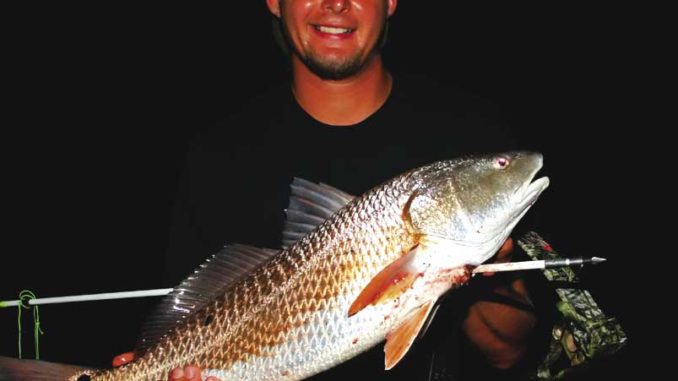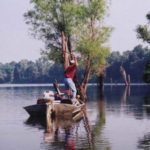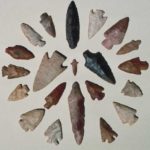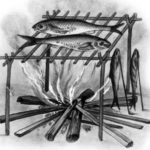
Many of our fishing techniques in Louisiana originated with our Indian anchestors.
Natchitoches has long been a popular destination for tourists. One such visitor was André Pénicaut, who traveled all the way from France to experience Louisiana. While staying in Natchitoches, Penicaut noticed the locals using trotlines to catch fish. Having never seen such a thing in France, he wrote a detailed account of this effective fishing tactic.
“They pulled up their nets from the lake filled with fish of all sizes. These nets, actually, are no more than fishing lines about (36 feet) long. All along these lines, numerous other little lines are tied a foot apart. At the end of each line is a fish hook on which they put a bit of sagamité dough or a small piece of meat. With this method they do not fail to catch fish weighing more than fifteen or twenty pounds. The end of the line is tied to their boats. They pull the lines up two or three times a day, and they always catch many fish when they do.”
Pénicaut visited Louisiana more than 300 years ago, and the fishermen he described were Natchitoches Indians. His journal reminds us that many of our “modern” fishing techniques were developed long ago by Native Americans.
Most people today think the Indians relied on deer, buffalo and bear for food. Actually, both the archaeological and historical evidence indicates that for thousands of years, Louisiana Indians probably depended more on fish than wild game.
Indians usually lived on streams and lakes, and fishing was much easier and more convenient than going on long hunts. Fish were such an important part of Native American life, in fact, the chiefs along the Mississippi River often sent fish as gifts to other Indians and European explorers.
In the marsh country of South Louisiana, Indians also ate huge amounts of rangia clams. These small brackish-water clams have little meat and are very low in protein. One study discovered it would take 81 clams to get just 2.4 ounces of meat. Rangia may be a poor food source, but they are found in huge quantities and were exploited for thousands of years.
Today throughout the marsh, outdoorsman sometimes run across shell middens, chenier-like ridges that can be more than 10 feet high. They were built up over hundreds of years by Indians eating and discarding the shells of rangia clams.
South Louisiana Indians may also have targeted saltwater fish. Shark teeth are sometimes found in archaeological sites, and were known to have been used as trade items. No evidence has been found of Louisiana Indians going into the Gulf itself, but they may have used weirs to trap fish. Early Spanish explorers reported Indians on Florida’s Gulf coast used rocks to build large weirs on bays to trap rays and other fish when the tide went out.
Surprisingly, there is little evidence prehistoric Indians ate oysters, crawfish, crabs or shrimp, but they must have done so because the Europeans claimed the historic Indians frequently utilized these food sources. Even the Natchez were said to have traveled all the way down the Mississippi River to its mouth just to collect oysters.
A Frenchman reported the Colapissas and Paskagoulas on the Mississippi Gulf coast filled their boats with oysters at low tide, shucked them and put then in a pot of water to slightly boil the meat. After the water was drained off, the oysters were placed on a grill made from cane and smoked on both sides until they were a golden yellow.
The oysters shriveled up to about the size of a bean, and were put in jars or sacks and hung in a cool, dry spot. When eaten, they were first soaked in fresh water for an hour and then cooked.
The Frenchman reported, “After that, whether one eats them as sauce with chickens, fried, or as dough made into fritters, they are equally good and never smell of the smoke.”
Smoking was also used to preserve freshwater fish. The same Frenchman wrote, “I saw this secret method employed by the Natchez where the carps caught are very fine and very fat.”
Crawfish were another plentiful food source. There is little written about how Indians caught them in Louisiana, although one source indicates that frog legs were used as bait.
In the Carolinas, an Englishman witnessed Indians using a crawfish technique that was simple but effective. They cut venison into thin strips, inserted the strips into reeds about every six inches, and stuck a large number of baited reeds in the water.
“Thus the Indians sit by and tend these baited sticks, every now and then taking them up to see how many are at the bait; where they generally find abundance, so take them off and put them in a basket for the purpose, and stick the reeds down again. By this method, they will, in a little time, catch several bushels, which are as good as any I ever eat.”
Indians who lived in Louisiana’s interior took advantage of every freshwater fish species. Archaeological sites are filled with the bones of catfish, gar, choupique, perch, bass, shad, gou and buffalo.
Their methods of taking fish were as varied as they were ingenious, and would be recognized by any fisherman today. Hooks and lines (including trotlines) were popular, with hooks being made from bone and line from sinew.
Archaeologists have found tear-shaped polished stones with holes or grooves in the top in sites from the Poverty Point Period (2,000-750 B.C.). These stones were first thought to be bola weights for throwing at ducks or small game, but are now believed to have been weights for nets or trotlines.
Sometimes elaborate weirs were placed on small streams to funnel fish into an enclosure where they could not escape. One discovered in Mississippi was made from split-cane netting and was 30 to 40 feet long. Radio carbon dating showed it was made several decades before Columbus landed in America.
The Chitimacha of South Louisiana used nets and wooden slat traps. The nets were made from vines, grass and tree bark, and included both gill and hoop varieties. Hoop nets were made from rabbit vine and were attached to round wooden frames and placed at the mouths of bayous.
The Natchez were said to have used special nets made from tree bark to catch “sardines” when they were running up the Mississippi River, but it is not clear what type of fish these “sardines” were.
The Chitimacha’s favorite fishing technique was to swim underwater with small nets made from hemp. These nets were about 3 feet long and 3 feet in diameter, and had elastic green cane fixed on each side to serve as a spring.
A number of men lined abreast across a long pond and then swam underwater, keeping their net open in front of them by pulling the green cane back with both hands. The men stayed underwater until they either ran out of breath or their nets were full of fish. When the nets were full, they let go of the cane and it sprang shut to close the opening.
One Frenchman who participated in this type of fishing wrote, “I have been engaged half a day at a time, with the old-friendly Chikkasah, and half drowned in the diversion — when any of us was so unfortunate as to catch water-snakes in our sweep, and emptied them ashore, we had the ranting voice of our friendly posse comitatus, whooping against us, till another party was so unlucky as to meet with the like misfortune. During this exercise, the women are fishing ashore with coarse baskets, to catch the fish that escape our nets.”
Spearing fish with harpoons or bows and arrows was also quite effective, with Indians sometimes using torches to hunt at night. One Troyville-Coles Creek site (400-1200 A.D.) on Grand Bayou in Iberville Parish contained a huge amount of fish bones (some from fish over 3 feet long) but no fishhooks. However, a number of bone harpoon and spear points were dug up.
Harpoon shafts were usually made from ash, cypress or willow because they float, and a fisherman could retrieve his harpoon in case of a miss. When a hit was made, the fish also quickly tired from dragging the buoyant shaft across the surface.
Gar bones are one of the most common bones found in archaeological sites, probably because they can be speared on the surface. I once employed a Koasati (Coushatta) Indian basket weaver, and he told me of a traditional method of catching gar that he had personally used. He claimed all one had to do was sit on the bank and sing a mystical gar fish song that would draw the fish into the bank where you could easily spear them.
When going after big fish, such as catfish, the Natchez used an arrow tipped with a bone point. This point was sharpened on both ends and was inserted into the arrow so the back of the point protruded from the shaft. The front tip cut through the fish and the back tip served as a barb to prevent the arrow from coming out. A cord was tied to the arrow and a block of wood that served as a float to prevent the fish from getting away.
The Natchez also built platforms out over the Mississippi River to spear fish. French writers did not indicate what species of fish were taken, but it was probably gar. Le Page Du Pratz, an early French explorer, noted that the fierce Natchez made their war arrow points from gar scales.
No matter what fishing technique was used, all Louisiana Indians relied on dugout canoes to cruise the lakes and bayous. These boats were very durable but took considerable time and skill to make. Because they did not have iron axes or adzes, the Indians had to use fire and shells as tools to shape the boats.
French explorers marveled at how adept the Indians were in making large dugouts. They first used fire to burn down a cypress tree (sometimes a cottonwood or poplar) and get the appropriate length log. A fire was then made along the top of the log, with layers of moist clay being placed on the ends and along the sides to protect those areas.
Once the fire had burned a while, it was extinguished and shells were used to scrape out the charcoal. The process was repeated until the log was hollowed out. It then was turned over and the same method was used to get it into final shape. The finished boat had sloping bows and was the same width along its entire length.
Early Spanish explorers reported fighting Indians on the Mississippi River who attacked in boats that carried 80 warriors, and the French wrote of dugouts 40 feet long, 3 feet wide and 3 inches thick.
One impressive dugout was found protruding from the bank of the Red River near Shreveport some years ago, and was excavated by archaeologists. Today, this 29-foot-long, 1,000-year-old boat is on display at Shreveport’s Louisiana State Exhibit Museum.
During late summer when streams dried up into small pools, dugouts were not necessary to catch fish.
The Choctaw and other tribes sometimes made poison by pounding up buckeyes, green walnut and hickory nuts, or devil’s shoestring and mixing it into the water. The poison affected the fish’s gills and suffocated them. Once they floated to the top of the water, they were scooped up by hand. When using this technique, the Choctaw often cut brush and put it around the pools to keep animals and people from drinking the water.
Alternatives to poisoning included constructing a drag by bundling brush together with vines or simply muddying the water. The drags were drawn through the pools like seines to push the fish upon the bank. If the water was deep, horses or oxen were used to pull the drag while the men sat on top of it to keep it underwater.
Muddying the water simply involved people tromping through the pool to stir the thick bottom sediment. The muddy water affected the fish the same way as poison, and they soon came to the surface.
Spanish explorers reported some of their Indian prisoners used this method in the Mississippi River swamps. One Spaniard wrote they “roiled the water with the mud of the waters and the fish, as if stupefied would come to the surface, and they caught as many as they wished.”
As white settlers spread across the South, they adopted many of the Indians’ fishing methods. My mother recalled going to bar pits along the railroad track during the Depression to catch fish by muddying the water. My grandfather put on his rubber boats and churned up the mud while she and her siblings scooped up small bream. And, although I never witnessed it while growing up in Winn Parish, I remember a number of people talking about using buckeyes to poison fish in Big Creek and Dugdemona River.
My uncle also told tales of Depression-era Union Parish, where he and his friends used carbide lamps to spot Opelousas catfish in Corney Creek and spear them with harpoons.
The October 2003 issue of Louisiana Sportsman includes an article I wrote about Terry Crum and his Ft. Necessity friends spearing large gar with cypress shaft harpoons. Little did I realize at the time, I was simply witnessing a fishing technique that has been used in Louisiana for thousands of years.







